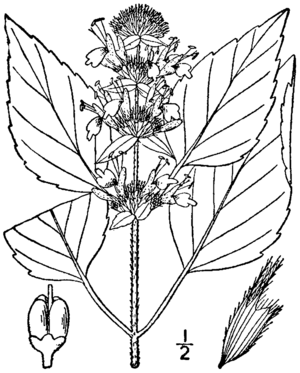Hairy wood-mint facts for kids
Quick facts for kids Hairy wood-mint |
|
|---|---|
 |
|
| Blephilia hirsuta | |
| Scientific classification | |
| Genus: |
Blephilia
|
| Species: |
hirsuta
|
| Varieties | |
|
|
| Synonyms | |
|
Monarda hirsuta Pursh |
|
The Blephilia hirsuta is a special plant from the mint family called Lamiaceae. It grows year after year in eastern North America. You might know it better as hairy wood-mint or hairy pagoda plant. It's a lovely plant that adds beauty to forests and gardens.
Contents
What is Hairy Wood-Mint?
Hairy wood-mint is a plant that comes back every year, which means it's a perennial. It usually grows to be about 30 to 120 centimeters (1 to 4 feet) tall. The main stem of the plant has long, soft white hairs. At the top of the stem, you'll find several groups of flowers that grow in circles.
Flowers and Leaves
The flowers of the hairy wood-mint can be light blue, pale purple, or even white. They often have tiny purple spots. Each flower is about 1 centimeter (0.4 inches) long. They have two main 'lips' and two parts that stick out, called stamens. The flowers bloom in the summer for about a month and a half.
The leaves of this plant grow opposite each other along the stem. They are long and thin, getting wider near their base. If you gently crush a leaf, you'll notice a pleasant, minty smell! The stems grow from a system of underground stems called rhizomes. These rhizomes also have many small, fibrous roots.
How It Got Its Name
The hairy wood-mint was first described by a botanist named Frederick Traugott Pursh in 1814. He called it Monarda hirsuta. Later, another botanist, George Bentham, gave it the name we use today: Blephilia hirsuta. The word hirsuta comes from Latin, and it means "hairy." This name fits the plant well because of the soft hairs on its stem.
Where Hairy Wood-Mint Grows
You can find hairy wood-mint in many places across eastern North America. In Canada, it grows in southern Quebec and Ontario. It's also common in many eastern states of the United States. These include Connecticut, Florida, Indiana, Kentucky, Minnesota, Nebraska, North Carolina, Tennessee, West Virginia, and Wisconsin.
Preferred Habitat
This plant likes to grow in rich, moist soil. You'll often see it in hardwood forests, next to streams and rivers, or in open areas within forests. It especially likes places where the soil has limestone underneath. Sometimes, it can even be found near wetlands. Hairy wood-mint prefers places with some sunlight or light shade. It thrives in forests that have small, natural disturbances, like a tree falling and creating a gap in the canopy.
Why Hairy Wood-Mint is Important
While people don't usually eat hairy wood-mint, it's a popular plant for gardens. People love to plant it because it's beautiful and smells wonderful. When you crush its leaves, they give off a fresh, minty scent.
Some plants in the mint family have been used for medicine. For example, a plant related to hairy wood-mint, called Blephilia ciliata, was used by the Cherokee people. They would make a special paste from it to help with headaches. Scientists are still learning about all the possible benefits of plants like these.
Hairy Wood-Mint and Animals
Many different insects help the hairy wood-mint grow by pollinating its flowers. Pollination is when pollen is moved from one flower to another, helping the plant make seeds.
Pollinators
- Bees: Many types of bees, like honeybees, mason bees, and miner bees, visit the flowers. They often come for the sweet liquid called nectar.
- Flies: Some flies, such as bee-flies and syrphids, also help pollinate.
- Butterflies: Different kinds of butterflies, including skippers, are attracted to the flowers.
These insects get a reward, like nectar or pollen, when they visit the flowers. This helps the hairy wood-mint spread its seeds and grow new plants. Animals like deer or other mammals probably don't eat the leaves of this plant very much.
Protecting Hairy Wood-Mint
For most of its range, the hairy wood-mint is a common and safe species. This means there are plenty of them growing. However, in some places, it needs special attention.
- In Connecticut, it's listed as a species of 'special concern'.
- In Vermont, it is considered 'threatened'.
- In Massachusetts, hairy wood-mint is an endangered species. This means it's at risk of disappearing from the wild there.
Scientists are still working to understand exactly what these plants need to be protected and thrive in all areas.
Images for kids


